
Price based on lowest available cruise only fare for double occupancy. Subject to change at any time.
Designed for polar exploration, Silver Endeavour is the new definition of luxury expedition travel.
We're proud to announce that our newest addition has joined the fleet. Silver Endeavour revolutionises our expedition voyages and allows deeper travel to some of the planet's farthest-flung coasts. Her statistics speak for themselves: unrivalled, industry-leading crew-to-guest, zodiac-to-guest, and expert-to-guest ratios, cutting-edge navigation and exploration technology, and hallmark Silversea comfort make her the most luxurious expedition ship ever built.
Sailing to both poles, our newest ship redefines the meaning of ultra-luxury expedition cruising. Her PC6 ice-class rating is one of the highest in the industry, while her state-of-the-art equipment and exploration technology offer one of the most advanced expedition experiences ever. Silver Endeavour introduces a new era in ultra-luxury expedition cruising, and brings the remote and remarkable to you in hallmark Silversea comfort. Join us for endless possibilities both onboard and on land aboard Silver Endeavour, the most luxurious expedition ship at sea.
Spread over eight public decks, Silver Endeavour features ample onboard space, multiple restaurants, and a huge choice of bars and lounges. Additionally, her large and luxurious suites are some of the best in expedition cruising. Superbly designed, all her suites feature a balcony and an impressive crew-to-guest ratio of 1:1.
Cruise ID: 22732
Setting sail on Silversea promises peace of mind from start to finish. That means no worrying about tipping the butlers or staff. Our crew-to-guest ratio of almost 1:1 ensures flawless service from pole to pole, but with us, you never have to think about who should get a tip, how much you should give and when. It's all included! We believe that not having to deal with tipping helps make your luxury cruise even more special and stress-free. And that is worth every penny.
| Date | Time | Price * | Booking |
|---|---|---|---|
| 29 June 2024 | 19:00 | €14,157 | Call us to book |
| 09 July 2025 | 19:00 | €31,205 | Call us to book |
* Price based on lowest available cruise only fare for double occupancy. Subject to change at any time.
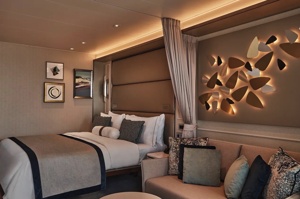
Deluxe Veranda Suites keep the iconic suite configuration - one of the most successful in the industry - while enhancing your creature comforts and destination immersion. Located on the privileged upper mid levels, Deluxe Veranda Suites have spacious interiors with a bedroom area that includes a large writing desk and comfortable living room with a convertible sofa (able to accommodate a third berth). Even better, the balcony is larger and more beautiful than ever, offering ample space to relax and enjoy sweeping views, wherever you are.
One bedroom: 33.1 sq.m. including veranda
Please note that the 3rd guest will sleep on a comfortable sofa bed in the reception area of the suite.
Images are intended as a general reference. Features, materials, finishes and layout may be different than shown.
Essentials
Characteristics
Furniture
Media & Communication
Onboard Services
Amenities
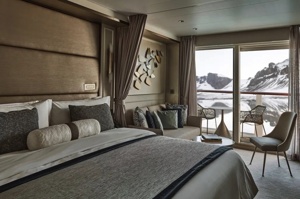
The Superior Veranda Suite is found on the upper decks. From the sumptuous views from the teak veranda to the spacious sitting room (with sofa bed able to accommodate a third berth) and large marble bathroom, everything about the Superior Veranda has been designed for your comfort. A comfortable living space, attention to detail and a generous expanse of amenities makes this stunning suite a cosy home while on the seas.
One bedroom: 33.1 sq.m. including veranda
Please note that the 3rd guest will sleep on a comfortable sofa bed in the reception area of the suite.
Images are intended as a general reference. Features, materials, finishes and layout may be different than shown.
Essentials
Characteristics
Furniture
Media & Communication
Onboard Services
Amenities
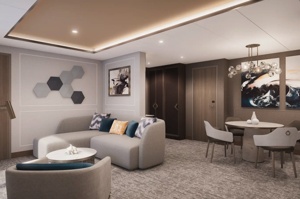
Get closer to your destination with Silver Endeavour's Signature Suite! Located on deck eight, this beautiful accommodation offers a wonderfully large living room, a dining area, a separate bedroom and a bathroom with walk-in shower and whirlpool bath. But surely the best thing about the Signature Suite is the huge private veranda and floor-to-ceiling glass walls, offering you sweeping views whether you are at the tip or toe of the world. The Signature Suite is one of our favourite places to melt into enjoy serene polar landscapes after a day of on shore exploring.
One bedroom: 67-78 sq.m. including veranda
Images are intended as a general reference. Features, materials, finishes and layout may be different than shown.
Essentials
Characteristics
Furniture
Onboard Services
Amenities
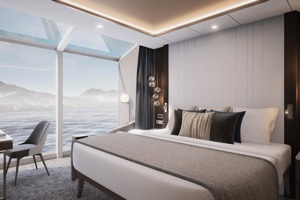
One of our most sumptuous suites ever designed! With innovative domed glazing surrounding the living areas and one of the largest balconies on board, the Master Suite offers complete destination immersion at sea. Floor-to-ceiling windows provide wow-factor 270° views, while the beautifully appointed living and dining areas, separate bedroom and bathroom with walk in shower and whirlpool bath ensure complete in suite comfort. If you have ever wanted to experience expedition travel while not missing on luxury, Silver Endeavour's Master Suite is the answer.
One bedroom: 108 sq.m. including veranda
Images are intended as a general reference. Features, materials, finishes and layout may be different than shown.
Essentials
Characteristics
Furniture
Media & Communication
Onboard Services
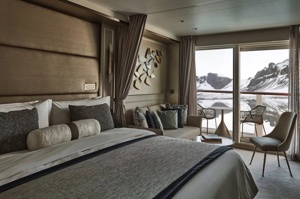
Located lower bow, the Classic Veranda Suite offers all the comfort and attention to detail that you can expect aboard — both inside and out. A generous expanse of interior comforts — elegant décor, stunning marble bathroom and ample seating area (with sofa bed that is able to accommodate a third berth), offers everything you need for a comfortable cruise. But perhaps this suite's finest asset lies just outside, as floor-to-ceiling glass doors open onto a private veranda, making every sunset feel as if it is yours alone.
One bedroom: 33.1 sq.m. including veranda
Wheelchair accessible suite has a bathroom with vanity and shower.
Please note that the 3rd guest will sleep on a comfortable sofa bed in the reception area of the suite.
Images are intended as a general reference. Features, materials, finishes and layout may be different than shown.
Essentials
Characteristics
Furniture
Media & Communication
Onboard Services
Amenities
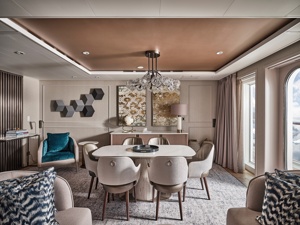
Supremely spacious and superbly located, the Owner's Suite is the most luxurious suite on board. Located in the premium bow position on deck seven, the Owner's Suite offers amazing destination immersion, thanks its enormous surrounding balcony and incredible views from all indoor areas. The large living room, separate dining area and well-stocked bar are perfect for sharing a moment with like-minded travellers, while the luxurious and well-appointed bedrooms ensure supreme comfort any time of the day or night.
One bedroom: 173.5 sq.m. including veranda
Main bedroom has a large walk-in wardrobe with personal safe and a bathroom with double vanity, walk-in shower and whirlpool bath.
Second bedroom has a separate wardrobe and a bathroom with walk-in shower.
Images are intended as a general reference. Features, materials, finishes and layout may be different than shown.
Essentials
Characteristics
Furniture
Media & Communication
Onboard Services
Amenities
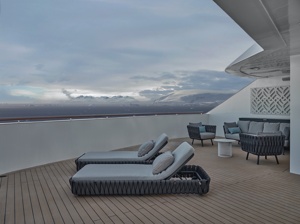
The Grand Suite is one of the most luxurious and spacious suites on board Silver Endeavour. It guarantees sweeping views of your destination thanks to its large balcony. A spacious interior includes a large living room, separate dining area and large bedroom with a big walk-in wardrobe. A luxurious bathroom with double vanity, whirlpool bath and walk-in shower completes. In addition, the Grand Suite also includes a small, second bedroom able to accommodate a third berth.
One bedroom: 155 sq.m. including veranda
Two bedroom: 188.1 sq.m. including veranda
Third guest can be accommodated in an additional single bed bedroom.
Images are intended as a general reference. Features, materials, finishes and layout may be different than shown.
Essentials
Characteristics
Furniture
Media & Communication
Onboard Services
Amenities
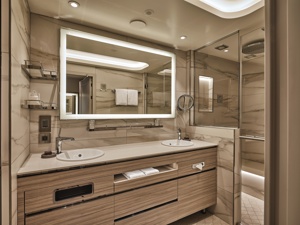
No Silversea ship would be complete without our guests' favourite Silver Suite. Located on deck eight, the Silver Suite promises stunning views of the destination thanks to its floor-to-ceiling window and large balcony. The spacious living area allows for comfortable relaxing while the dining area makes cosy nights in veritable experiences in themselves. Additionally, Silver Suites feature generous walk-in wardrobes as well as a bathroom with a large walk-in shower, vanity and separate lavatory.
One bedroom: 49.7 sq.m. including veranda
Please note that the 3rd guest will sleep on a comfortable sofa bed in the reception area of the suite.
Images are intended as a general reference. Features, materials, finishes and layout may be different than shown.
Essentials
Characteristics
Furniture
Media & Communication
Onboard Services
Amenities
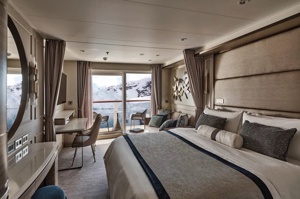
Our best-selling Premium Veranda Suite is more beautiful and luxurious than ever on board Silver Endeavour. This suite offers a large bedroom space with dreamy bedding, a stunning marbled bathroom with a large vanity and sumptuous walk-in shower. Comfortable furnishings and elegant decor make staying in (almost) as good as going out! Spacious and well-situated, enjoy ultra-luxury amenities from the 24-hour butler service to the well-stocked mini-bar (and yes, they're all included!). The sofa-bed can easily accommodate a third guest.
One bedroom: 33.1 sq.m. including veranda
Please note that the 3rd guest will sleep on a comfortable sofa bed in the reception area of the suite.
Images are intended as a general reference. Features, materials, finishes and layout may be different than shown.
Essentials
Characteristics
Furniture
Media & Communication
Onboard Services
Amenities
Day 1 Reykjavík, Iceland
Sprawling Reykjavík, the nation's nerve center and government seat, is home to half the island's population. On a bay overlooked by proud Mt. Esja (pronounced eh-shyuh), with its ever-changing hues, Reykjavík presents a colorful sight, its concrete houses painted in light colors and topped by vibrant red, blue, and green roofs. In contrast to the almost treeless countryside, Reykjavík has many tall, native birches, rowans, and willows, as well as imported aspen, pines, and spruces.Reykjavík's name comes from the Icelandic words for smoke, reykur, and bay, vík. In AD 874, Norseman Ingólfur Arnarson saw Iceland rising out of the misty sea and came ashore at a bay eerily shrouded with plumes of steam from nearby hot springs. Today most of the houses in Reykjavík are heated by near-boiling water from the hot springs. Natural heating avoids air pollution; there's no smoke around. You may notice, however, that the hot water brings a slight sulfur smell to the bathroom.Prices are easily on a par with other major European cities. A practical option is to purchase a Reykjavík City Card at the Tourist Information Center or at the Reykjavík Youth Hostel. This card permits unlimited bus usage and admission to any of the city's seven pools, the Family Park and Zoo, and city museums. The cards are valid for one (ISK 3,300), two (ISK 4,400), or three days (ISK 4,900), and they pay for themselves after three or four uses a day. Even lacking the City Card, paying admission (ISK 500, or ISK 250 for seniors and people with disabilities) to one of the city art museums (Hafnarhús, Kjarvalsstaðir, or Ásmundarsafn) gets you free same-day admission to the other two.
Day 2 Cruising
Day 3 Skjoldungen, Greenland
Located on Greenland's relatively rarely visited rugged east coast, Skoldungen Fjord has enchanting scenery with towering mountains tipped with snow, ice-scraped valley sides and sculptured icebergs in shades of white and blue. At the top of the fjord one can easily see the retreating state of the Thrym Glacier. The U-shaped fjord offers spectacular scenery and as an extra perk, it is not uncommon to see whales in the fjord.
Day 4 Aappilattoq, Greenland
Aappilattoq is a small settlement near the western end of Prins Christian Sund in southwestern Greenland. In the local Greenlandic language the name means, "sea anemone". This small village of 130 inhabitants, hidden behind a prominent rock, offers a good insight into the life of Greenlandic Inuit. A stroll through the village will reveal a small school and a church, along with the likely possibility of seeing a polar bear skin drying in the wind behind a local dwelling. People have lived off the land in the area around Aappilattoq since the 19th century. The tradition continues today as most people here hunt and fish to make a living.
Day 5 Hvalsey, Greenland
Northeast of Qaqortoq and at the end of a fjord, Hvalsey is one of the best examples of South Greenland's many scattered ruins from the Norse period. Today the area is used for sheep-grazing, but until the 15th century the settlement at Hvalsey, and specifically Hvalsey's church, played an important part. Christianity had spread its influence throughout Europe and eventually had reached remote Greenland, where it established itself in the country in 1000 AD. Hvalsey Church was built in the 14th century and is the best preserved of the churches in Greenland from that period. Apart from the church walls, historical ruins from the time of the Norse are just a few meters away.
Day 6 Cruising
Day 7 Nuuk (Godthaab), Greenland
Nuuk, meaning “the cape”, was Greenland's first town (1728). Started as a fort and later mission and trading post some 240 kilometers south of the Arctic Circle, it is the current capital. Almost 30% of Greenland's population lives in the town. Not only does Nuuk have great natural beauty in its vicinity, but there are Inuit ruins, Hans Egede's home, the parliament, and the Church of our Saviour as well. The Greenlandic National Museum has an outstanding collection of Greenlandic traditional dresses, as well as the famous Qilakitsoq mummies. The Katuaq Cultural Center's building was inspired by the undulating Northern Lights and can house 10% of Nuuk's inhabitants.
Day 8 Cruising
Day 9 Iqaluit, Nunavut, Canada
Iqaluit is the capital of Canada's newest territory, Nunavut, which is Inuktitut for “our land”. The community is located at the head of Frobisher Bay, an inlet of the North Atlantic extending into southeastern Baffin Island. The Bay is so long that it was first taken to be the possible entrance of a Northwest Passage. In Iqaluit, the Nunatta Sunakkutaangit Museum and the Nunavut Legislative Assembly Building both house incredible collections of Inuit artwork with interesting local prints for sale in the museum shop.
Day 10 Monumental Island, Baffin Islands, Nunavut, Canada
Monumental Island in Davis Strait was named by Arctic explorer Charles Francis Hall as a tribute to the memory of Sir John Franklin who died in his quest to find the Northwest Passage. The island is offshore of Baffin Island in the Canadian Arctic Archipelago of the territory of Nunavut. Around the shoreline scores of Black Guillemots dive and fish for little Arctic cods and capelins. Successful birds fly off with a minnow grasped tightly in their beaks. On a far larger scale, it is possible to find groups of walruses with their impressive tusks along the shores of the island. However, the coup de grâce is to spot a polar bear's white silhouette against the dark background of the bedrock on Monumental Island.
Day 11 Akpatok Island, Nunavut, Canada
Akpatok Island is the largest island in the middle of Ungava Bay, south of Baffin Island and north of Quebec. Its name is the local name for the Thick-billed Murre, which nests here in vast numbers. In fact, the entire island is designated a Canadian Important Bird Area. Other common wildlife are Polar bears, seals, and walrus. One of the most distinctive features of the island is the steep limestone cliffs ringing the shore. They rise 490 to 820 feet straight up from the sea to a flat plateau. Although is uninhabited today, remains of a Dorset settlement have been documents at the southern end of the island.
Day 12 Kimmirut, Nunavut, Canada
Day 13 Cape Dorset, Nunavut, Canada
Cape Dorset is a small Inuit hamlet located on Dorset Island, off the southern shore of Baffin Island. The traditional name for Cape Dorset is Kinngait (meaning "high mountain"), describing the ‘Cape', which is actually a 800 foot mountain. This is a nature-lovers paradise with breath-taking landscapes and an amazing abundance of arctic wildlife, such as migratory caribou, seabirds, whales, seals and walruses. Ancient native Thule (Dorset Culture) peoples lived in this area for three thousand years, and it is here where the first archaeological remains were found. Captain Luke Foxe, during his attempt to find the Northwest Passage in 1631, was the first European to land here. He named the Cape in honour of his sponsor Edward Sackville, the Earl of Dorset. In 1913, the Hudson's Bay Company started a trading post, exchanging furs and skins for supplies like tobacco, ammunition, flour, gas, tea and sugar. In 1949, the market for white fox collapsed but the art industry boomed. Since the 1950s, Cape Dorset, the "Capital of Inuit Art", has become an economic mainstay of the community, with more than 20% of it residents employed in the arts.
Day 14 Coats Island, Nunavut, Canada
Day 15 Cruising
Day 16 Churchill, Manitoba, Canada
Day 17 Churchill, Manitoba, Canada
Day 1 Reykjavík, Iceland
Sprawling Reykjavík, the nation's nerve center and government seat, is home to half the island's population. On a bay overlooked by proud Mt. Esja (pronounced eh-shyuh), with its ever-changing hues, Reykjavík presents a colorful sight, its concrete houses painted in light colors and topped by vibrant red, blue, and green roofs. In contrast to the almost treeless countryside, Reykjavík has many tall, native birches, rowans, and willows, as well as imported aspen, pines, and spruces.Reykjavík's name comes from the Icelandic words for smoke, reykur, and bay, vík. In AD 874, Norseman Ingólfur Arnarson saw Iceland rising out of the misty sea and came ashore at a bay eerily shrouded with plumes of steam from nearby hot springs. Today most of the houses in Reykjavík are heated by near-boiling water from the hot springs. Natural heating avoids air pollution; there's no smoke around. You may notice, however, that the hot water brings a slight sulfur smell to the bathroom.Prices are easily on a par with other major European cities. A practical option is to purchase a Reykjavík City Card at the Tourist Information Center or at the Reykjavík Youth Hostel. This card permits unlimited bus usage and admission to any of the city's seven pools, the Family Park and Zoo, and city museums. The cards are valid for one (ISK 3,300), two (ISK 4,400), or three days (ISK 4,900), and they pay for themselves after three or four uses a day. Even lacking the City Card, paying admission (ISK 500, or ISK 250 for seniors and people with disabilities) to one of the city art museums (Hafnarhús, Kjarvalsstaðir, or Ásmundarsafn) gets you free same-day admission to the other two.
Day 2 Cruising
Day 3 Prince Christian Sound, Greenland
The transit through the Sound is one of this voyage's highlights. Connecting the Labrador Sea with the Irminger Seat, Prince Christian Sound or “Prins Christian Sund” in Danish is named after Prince (later King) Christian VII (1749-1808). 100 km (60 miles ), long and at times just 500 m (1500 ft) wide, this majestic and spectacular fiord throws you back into a Viking era – flanked by soaring snow-topped mountains, rock-strewn cliffs and rolling hills, it is as if time has stood still and one easily forgets that this is the 21st century. As you marvel at the sheer size of the mountains that surround you, with the Arctic waters lapping deceptively at the hull, revel in the silence enveloping you. Icebergs float serenely by, carrying with them the ages of time. Be sure to wear warm clothing as this is one spectacle that you do not want to miss.
Day 4 Hvalsey, Greenland
Northeast of Qaqortoq and at the end of a fjord, Hvalsey is one of the best examples of South Greenland's many scattered ruins from the Norse period. Today the area is used for sheep-grazing, but until the 15th century the settlement at Hvalsey, and specifically Hvalsey's church, played an important part. Christianity had spread its influence throughout Europe and eventually had reached remote Greenland, where it established itself in the country in 1000 AD. Hvalsey Church was built in the 14th century and is the best preserved of the churches in Greenland from that period. Apart from the church walls, historical ruins from the time of the Norse are just a few meters away.
Day 5 Paamiut (Fredrikshaab), Greenland
Day 6 Nuuk (Godthaab), Greenland
Nuuk, meaning “the cape”, was Greenland's first town (1728). Started as a fort and later mission and trading post some 240 kilometers south of the Arctic Circle, it is the current capital. Almost 30% of Greenland's population lives in the town. Not only does Nuuk have great natural beauty in its vicinity, but there are Inuit ruins, Hans Egede's home, the parliament, and the Church of our Saviour as well. The Greenlandic National Museum has an outstanding collection of Greenlandic traditional dresses, as well as the famous Qilakitsoq mummies. The Katuaq Cultural Center's building was inspired by the undulating Northern Lights and can house 10% of Nuuk's inhabitants.
Day 7 Sermiligaaq, Greenland
Day 8 Cruising
Day 9 Iqaluit, Nunavut, Canada
Iqaluit is the capital of Canada's newest territory, Nunavut, which is Inuktitut for “our land”. The community is located at the head of Frobisher Bay, an inlet of the North Atlantic extending into southeastern Baffin Island. The Bay is so long that it was first taken to be the possible entrance of a Northwest Passage. In Iqaluit, the Nunatta Sunakkutaangit Museum and the Nunavut Legislative Assembly Building both house incredible collections of Inuit artwork with interesting local prints for sale in the museum shop.
Day 10 Monumental Island, Baffin Islands, Nunavut, Canada
Monumental Island in Davis Strait was named by Arctic explorer Charles Francis Hall as a tribute to the memory of Sir John Franklin who died in his quest to find the Northwest Passage. The island is offshore of Baffin Island in the Canadian Arctic Archipelago of the territory of Nunavut. Around the shoreline scores of Black Guillemots dive and fish for little Arctic cods and capelins. Successful birds fly off with a minnow grasped tightly in their beaks. On a far larger scale, it is possible to find groups of walruses with their impressive tusks along the shores of the island. However, the coup de grâce is to spot a polar bear's white silhouette against the dark background of the bedrock on Monumental Island.
Day 11 Akpatok Island, Nunavut, Canada
Akpatok Island is the largest island in the middle of Ungava Bay, south of Baffin Island and north of Quebec. Its name is the local name for the Thick-billed Murre, which nests here in vast numbers. In fact, the entire island is designated a Canadian Important Bird Area. Other common wildlife are Polar bears, seals, and walrus. One of the most distinctive features of the island is the steep limestone cliffs ringing the shore. They rise 490 to 820 feet straight up from the sea to a flat plateau. Although is uninhabited today, remains of a Dorset settlement have been documents at the southern end of the island.
Day 12 Kimmirut, Nunavut, Canada
Day 13 Cape Dorset, Nunavut, Canada
Cape Dorset is a small Inuit hamlet located on Dorset Island, off the southern shore of Baffin Island. The traditional name for Cape Dorset is Kinngait (meaning "high mountain"), describing the ‘Cape', which is actually a 800 foot mountain. This is a nature-lovers paradise with breath-taking landscapes and an amazing abundance of arctic wildlife, such as migratory caribou, seabirds, whales, seals and walruses. Ancient native Thule (Dorset Culture) peoples lived in this area for three thousand years, and it is here where the first archaeological remains were found. Captain Luke Foxe, during his attempt to find the Northwest Passage in 1631, was the first European to land here. He named the Cape in honour of his sponsor Edward Sackville, the Earl of Dorset. In 1913, the Hudson's Bay Company started a trading post, exchanging furs and skins for supplies like tobacco, ammunition, flour, gas, tea and sugar. In 1949, the market for white fox collapsed but the art industry boomed. Since the 1950s, Cape Dorset, the "Capital of Inuit Art", has become an economic mainstay of the community, with more than 20% of it residents employed in the arts.
Day 14 Coats Island, Nunavut, Canada
Day 15 Cruising
Day 16 Churchill, Manitoba, Canada
Day 17 Churchill, Manitoba, Canada
The Department of Foreign Affairs has up-to-date advice for Irish citizens on staying safe and healthy abroad. For more security, local laws, health, passport and visa information see https://www.dfa.ie/travel/travel-advice/ and follow dfatravelwise